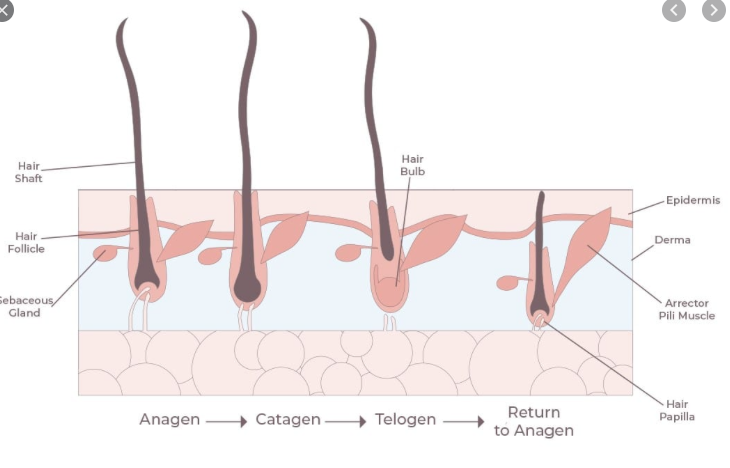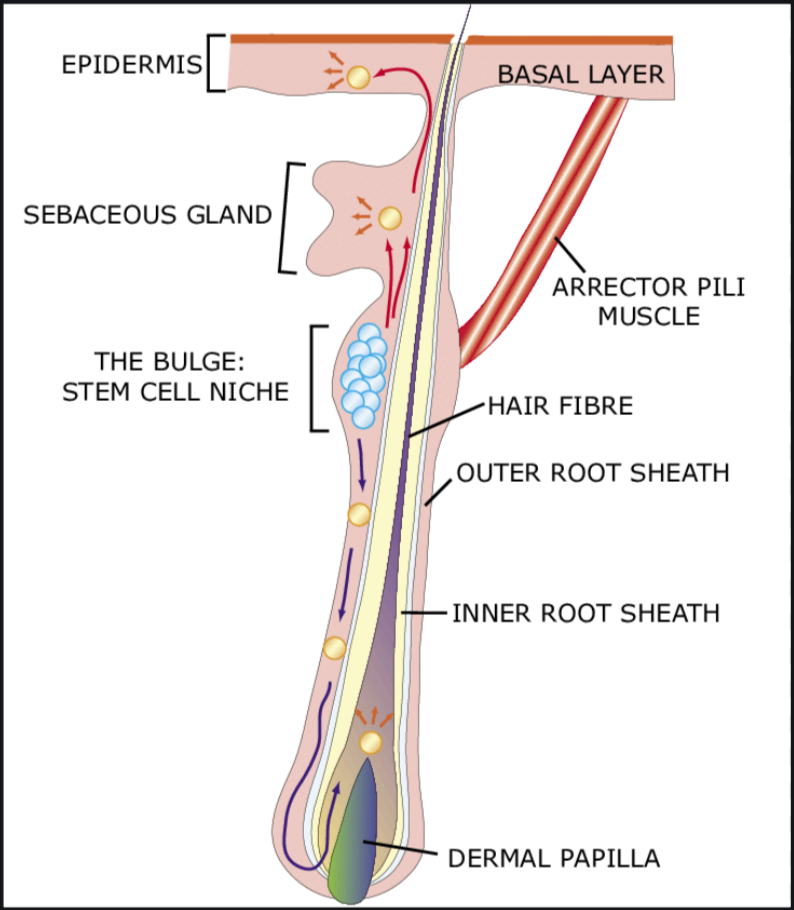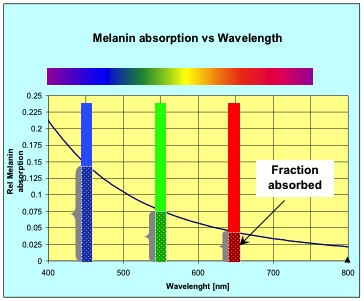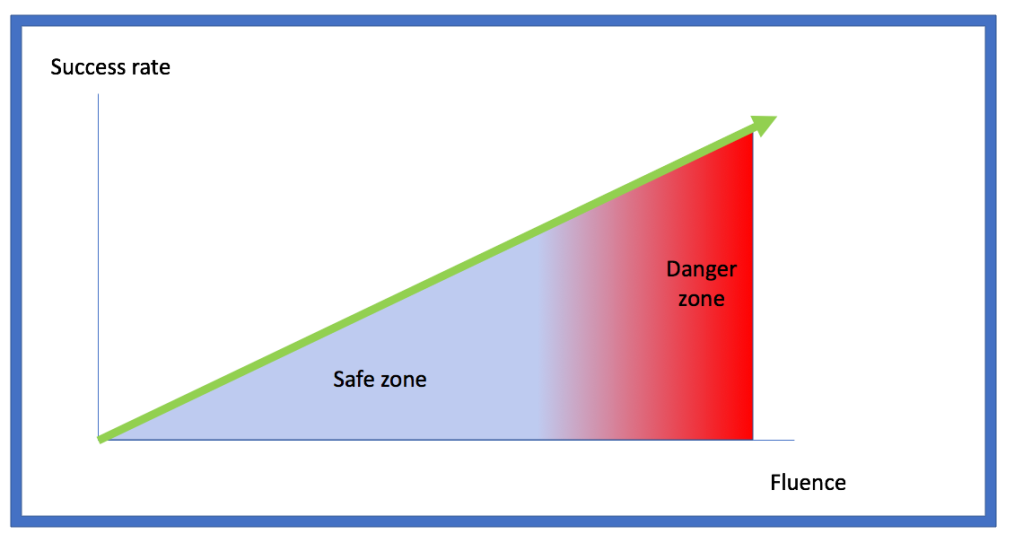
Privacy statement: Your privacy is very important to Us. Our company promises not to disclose your personal information to any external company with out your explicit permission.
Later we realised that we needed to use longer pulses to effectively denature the germ cells around follicles – these are the cells which determines the growth pattern of hair follicles.

However, nobody really knew what the `best` time interval between treatments should be. A consensus of six to eight weeks was adopted across the industry, with no real scientific or clinical backing.
This interval stuck. But it is entirely wrong!!
When you think about it, we really should be matching our treatment times to the growth phases of the follicles. These growth phases vary enormously across the body!! Our scalp hair grows for much longer times than our eyebrow hair, for example. Otherwise our eyebrows would reach our feet!
How does laser/IPL hair removal work?
Laser/IPL hair removal is based on the theory of `selective photothermolysis` where light is preferentially absorbed by a target (in this case, melanin). By doing this we can effectively concentrate the light energy into the target rather than the surrounding tissues. If we choose an appropriate time in which to deliver this light energy, we can significantly limit the thermal damage to the collagen around the follicles too.
So, we must choose both the wavelength (colour) of our light and its pulsewidth (cooking time) carefully to ensure maximum effectiveness.
However, the melanin in the hair shaft is NOT the real target!! It is merely a conduit. The real target are the germ, or stem, cells which are found in a region near to the insertion of the arrector pili muscle, which is quite high up the follicle. At this point we should consider the growth phases of hair.

It is known that there are essentially three growth phases of hair:
Anagen
This is the actively growing phase, when the local melanocytes are transferring melanin granules to the follicle – both the hair shaft and the follicle epithelium. During this phase the hair/follicle structure is at its `darkest` with melanin, with the full length of the hair shaft being pigmented. This is very important when considering any light-based treatment.
This phase can last from a few weeks to years (in the scalp).
Catagen
During catagen, the hair growth and melanin production stop abruptly. The lower part of the follicle undergoes a period of apoptosis – the cells die! At the same time, the base of the follicle moves towards the skin surface.
This phase typically last between 10 to 14 days in humans, for all hairs.
Telogen
This is commonly known as the `resting` phase. During this time there is no growth or melanin production. The germ cells become essentially dormant and the follicle is quiescent.
This phase can last anywhere between 6 weeks and 6 months, depending on the body site.
Early Anagen
In the late telogen phase, the germ cells begin to proliferate near the `bulge` region of the arrector pili muscles. This results in the formation of new follicular matrix cells and new melanocyte activity. A new hair bud begins to form, which `pushes` the old hair out of the follicle, as it grows upwards.

Clinical studies (see the references below) reveal that the melanin pigment distribution in the hair shaft is critical in achieving destruction of the follicular germ cells. This is why laser/IPL hair removal only works successfully on pigmented hair, and ONLY in the anagen phase when the hair shafts and follicles are fully pigmented.
The extent of follicular damage depends strongly on the fluence applied (energy density). Lower fluences result in `delayed growth` of follicles, while higher fluences can permanently destroy them. This is closely tied into the pulse duration (how long each light pulse is). Longer pulses result in more `cooking` of the follicles and hence the stem cells. If these cells are not cooked for a sufficiently long period then they may recover, and re-generate the follicle, usually with a finer hair (which is more difficult to kill!)
Think of this in terms of boiling an egg – if your water is boiling in a pot (at 100C) and you place an egg into it for only 1 minute, the egg will not be properly cooked. That`s simply because there was insufficient time to cook it thoroughly. We all know the egg must remain in the water for at least 3.5 to 4 minutes.
This principle can be applied to hair treatments – if the germ cells are not cooked for a long enough time, they will survive. That`s the difference between a successful treatment and `re-growing hairs`!! (Incidentally, this principle also applies when treating blood vessels).
| Body Area | %Resting Hairs Telogen | %Growing Hair Anagen | Duration of Telogen | Duration of Anagen | Approx. Depth of Terminal Anagen Follicles |
| Scalp | 15 | 85 | 3 – 4 months | 2 – 6 years | 3 – 5 mm |
| Eyebrow | 90 | 10 | 3 months | 1 – 2 months | 2 – 5 mm |
| Ear | 85 | 15 | 3 months | 1 – 2 months | |
| Cheeks | 30 – 50 | 50 – 70 | – | – | 2 – 4 mm |
| Beard(Chin) | 30 | 70 | 8.5 months | 1 year | 2 – 4 mm |
| Moustache(Upper Lip) | 35 | 65 | 1.5 months | 4 months | 1 – 2.5 mm |
| Armpits | 70 | 30 | 2 months | 4 months | 3.5 – 4.5 mm |
| Pubic Area | 70 | 30 | 3 months | 6 months | 3.5 – 4.75 mm |
| Arms | 80 | 20 | 4.5 months | 13 weeks | |
| Legs & Thighs | 80 | 20 | 6 months | 4 months | 2.5 – 4 mm |
Table 1:
Anagen and telogen data in humans
We also need to figure out the `best` fluence to achieve the best results. The last column in table 1 shows the depths of these hair follicles during the anagen phase. These can vary between 1 and 5 mm deep. This suggests that we must use a range of fluences across the body to properly heat up the target hairs. Those fluences will depend strongly on the depths of the follicles.

The success rate of a light-based treatment
depends on the fluence, but so does the danger element.
Time between repeat sessions
So, we know that we can successfully destroy some follicles permanently if we apply the correct laser/IPL fluence and pulsewidths. But, how long do we wait until the next treatment session?
This is a little tricky-
The hair growth cycles are continuous. That means that the follicles across the body are in anagen, catagen and telogen phases all the time.
But we cannot tell which ones are in which phase, without a detailed analysis of every hair!!
So, we must proceed on the basis that we can only successfully damage a portion of any hairy region at any one time. The data in table 1 was gathered from studies on people in the 60s and 70s. This data tells us what proportion of hairs are in anagen or telogen phase, their durations and the depths of the hairs across various parts of the body.
Let`s look at `armpit` hair-
From table 1 we see that around 30% of armpit hair is in anagen, at any given time. So, we can only destroy 30% of these hairs in any one treatment. But this means that, in theory, we could destroy another 30% in the 2nd treatment, another 30% in the 3rd treatment, and the final 10% in the 4th
treatment.
In theory, we could destroy ALL armpit hair follicles in four sessions!!
But, at what point after each treatment will 30% of the follicles be back in anagen phase?
The table tells us that the anagen phase typically lasts for 4 months while the telogen phase lasts for 2 months. But of course, the hairs are all `out of phase` with each other. They don`t grow `synchronously`!!
So the answer is `we don`t really know`! If we wait for 2 months (a full telogen phase cycle), then some of the undamaged follicles will definitely be back in anagen. If we wait for a full anagen phase cycle (4 months), then more follicles will probably be back in anagen phase. But we can`t tell which ones! (Note that none of this applies to `dormant` follicles. There are always some follicles which are not normally active. These might be forced into activity through hormonal changes, pregnancy, trauma or a particularly spicy curry!!)
I suppose the `best` answer is `the longer, the better`. But this is not acceptable in the real world when customers want all their hair removed [yesterday"!!!!
So, we need to compromise. My current thinking is that if we leave a full anagen phase cycle between repeat treatments, then we will be able to target many newly growing follicles. (If someone has a better idea, I`d love to hear it!)
This suggests that for armpit hair, we should probably leave a gap of 4 months between sessions, to maximise the treatment effectiveness. However, many clients will not find this acceptable – it`s too long a gap.
The answer here is to compromise with them. Explain the timings in table 1 to your clients and tell them that, in theory, longer gaps between sessions will result in fewer repeat sessions.
However, you can treat them more frequently than the table suggest, but they will inevitably undergo a higher number of sessions. Ultimately, it`s up to them, but at least you`ve given them the option. But the overall time needed to remove all the follicles is still the same (4 sessions, 4 months apart will take 12 months in total from start to finish. 7 sessions at 2 month intervals will also take 12 months!!)
Conclusions
Laser/IPL hair removal is not easy! You need to consider the hair colour, thickness and depths. Then you need to match up your fluence and pulsewidths to match those hairs. Then you need to think about the best timings between sessions.
However, if you get all these correct, then your clients will be very happy with their results and your business will flourish.
LET'S GET IN TOUCH

Privacy statement: Your privacy is very important to Us. Our company promises not to disclose your personal information to any external company with out your explicit permission.

Fill in more information so that we can get in touch with you faster
Privacy statement: Your privacy is very important to Us. Our company promises not to disclose your personal information to any external company with out your explicit permission.